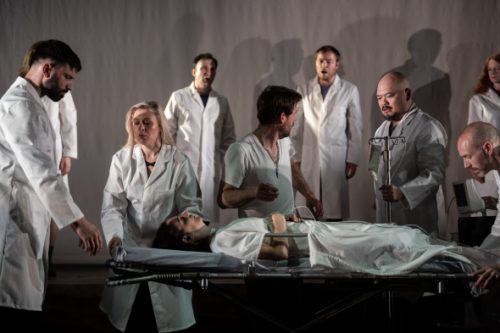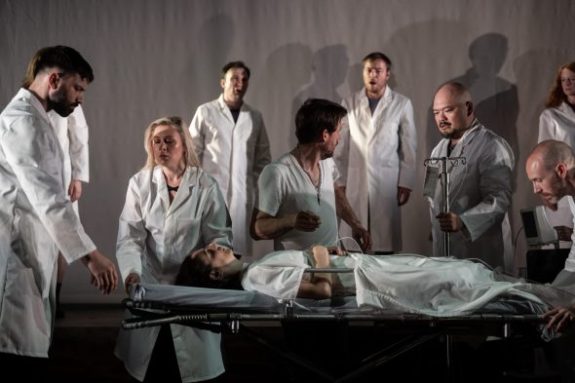 United Kingdom Longborough Festival Opera 2023 [3] – Monteverdi, L’Orfeo: Soloists, La Serenissima / Robert Howarth (conductor). Longborough, Gloucestershire, 18.7.2023. (CP)
United Kingdom Longborough Festival Opera 2023 [3] – Monteverdi, L’Orfeo: Soloists, La Serenissima / Robert Howarth (conductor). Longborough, Gloucestershire, 18.7.2023. (CP)

Production:
Director – Olivia Fuchs
Designer – Nate Gibson
Lighting designer – Tim Mitchell
Movement director – Clare Whistler
Cast:
Orfeo (Orpheus) – Peter Gijsbertsen
Euridice (Eurydice) – Aoife Miskelly
Prosperina / La Messeggera (The Messenger) – Frances Gregory
Caronte (Charon) – Freddie Tong
Ninfa (Nymph) – Rosie Lomas
La Musica (Music) – Caroline Taylor
La Sperenza (Hope) – Siân Cameron
Shepherd – Andrew Irwin
Apollo / Shepherd – Seumas Begg
Shepherd / Infernal Spirit – Nicholas Morris
Plutone (Pluto) / Shepherd / Spirit – Julien Ségol
Ensemble – Rozanna Madylus
As befits Longborough, their programmes are an excellent read. Dr Leah Broad’s article, Monteverdi and the Birth of Opera reminds listeners of Monteverdi’s use of ‘unprepared’ dissonance. Theorist Giovanni Artusi was affronted by this but Monteverdi’s style eventually won out. For many, this was the experience in the Cotswolds production.
Pit layout changes at Longborough are frequent; Götterdämmerung required an orchestra in excess of sixty players; L’elisir d’amore, a band of less than forty; L’Orfeo (or L’favola d’Orfeo) requires a special group of musicians to play in a pit in front of the stage, in full view of patrons. What a thrill to see and hear the theorbo, harp, harpsichord plus string and brass sections who comprise La Serenissima, playing their beloved baroque music, directed confidently, by Robert Howarth. With reduced pit space and no obvious entry point, members of the brass and wind sections were watched with considerable admiration as, in turn, individuals swung first one leg then the other over a pit wall. This was not Silverstone; however, pit walls can be a barrier in all sorts of circumstance! With musicians in place the work begins with the dramatic toccata, a trumpet flourish preceding the entry of La Musica, representing the ‘spirit of music’. As a tribute to those gymnastic efforts of the musicians, the cast present themselves en masse at the stage apron as a physical overture to the Greek legend which follows. A similar display of cast unity takes place at the conclusion of the work as action returns from the underworld to the present day; the conscious symmetry of the work completed. Monteverdi’s work straddles the late Renaissance and early Baroque, L’Orfeo, his first opera is considered a masterwork.

Director, Olivia Fuchs seized the opportunity to remind her audience of Monteverdi’s early years when his father, an apothecary in Cremona, would tell tales of life as an amateur surgeon. Fuchs’s imaginative interpretation of Monteverdi’s early work, composed soon after his move to Mantua, updated the then medical practices to the modern day. An all too familiar National Health hospital trolley, with intravenous injection supplying attachments, drip and monitor is prominently wheeled around the circular stage. Fuchs’s keenness to innovate the story with hospital trolleys and drum kits, both in and out of Hades, does not enhance the story as the fruitless efforts of Orfeo to bring Euridice, his dead bride, back to the living world, fail. Much of the action takes place either side of a small ‘proscenium’ arch on a raised part of the small stage. At times a vast shroud replaces the arch, at other times, the arch and adjacent pylons or stanchions are draped with fluorescent ‘weeping eyes’ to illuminate the sadness felt by the spirits of the underworld as the plot unfolds.
Caroline Taylor (La Musica) sparkles in her opening prologue in the fields of Thrace in which she praises her powers. Happiness prevails with Peter Gijsbertsen (Orfeo) – making a welcome return to Longborough – enjoying his new relationship with Euridice (Aoife Miskelly), accepting a shepherd’s invitation to celebrate with the striking arioso ‘Rosa del ciel’, well delivered though with a more baritonal than tenor timbre. So, too, was his display of distress on hearing the news of the snake bite which took his bride’s life. His resolve to bring her back from the underworld is supported by the solid chorus left to mourn. A white-coated hospital team with body on trolley, replaced the predominantly black-clothed chorus, allowing Siân Cameron (Hope) to guide Orfeo into the underworld behind the vast shroud. As Orfeo approaches this underworld, he is challenged by the fearsome Freddie Tong (Charon, the ferryman), a remarkable bass-baritone with a stage presence to match. With a twist to the story, in place of singing Charon to sleep, Orfeo smothers him with a chloroform-soaked cloth requesting he ‘be given back his life’.
Lighting designer, Tim Mitchell continues to offer Longborough the most dependable of lighting plots – the tear dropping lighting so very effective. Nate Gibson’s set design reminds audiences of what he created for Die tote Stadt, a success in Longborough 2022. Contemporary dress code meets Fuchs’s expectations and movement director Claire Whistler keeps the action fresh, if yet very dark on occasions.
Adrian Chandler leads the excellent La Serenissima. The oft-prominent sound of the theorbo, played by Lynda Sayce and harp by Oliver Wass, were Longborough treats, of which there have been many this season.
Clive Peacock
